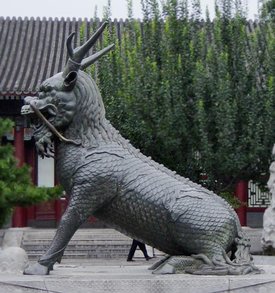Qilin
|
|
The qilin, also spelled kylin (Template:Zh-cpw; Cantonese: kay-lun; Hokkien: kee lin), or kirin (from Japanese), is a mythical hooved Chinese creature that is said to appear in conjunction with the arrival of a sage. It is a good omen that brings rui (Template:Zh-cp; roughly translated as "serenity" or "prosperity"). It is often depicted with what looks like fire all over its body.
| Contents [hide] |
The nature of the beast
MingQilinDragonFish.jpg
Although it looks fearsome, the qilin only punishes sinners. It can walk on grass and yet not trample the blades and it can also walk on water. Being a peaceful creature, its diet does not include flesh. It takes great care when it walks never to tread on any living thing, and it is said to appear only in areas ruled by a wise and benevolent leader (some say even if this area is only a house). It is normally gentle but can become fierce if a pure person is threatened by a sinner, spouting flames from its mouth and exercising other fearsome powers that vary from story to story.
Variations
There are variations in the appearance of the qilin, even as seen in a single country such as China, owing to cultural differences between dynasties and regions.
Ming dynasty example
In the Ming dynasty of China (1368–1644) the qilin is represented as an oxen-hooved animal with a dragon-like head surmounted by a pair of horns and flame–like head ornaments.
A Qing dynasty example
The qilin of China's subsequent Manchurian dominated Qing dynasty (1644–1911) is a much more fanciful animal. Manchurian depictions of the qilin depict a creature with the head of a dragon, the antlers of a deer, the skin and scales of a fish, the hooves of an ox and tail of a lion.
In Japan
In Japanese, the qilin is called a kirin. Japanese art tends to depict the qilin as more deer-like than in Chinese art. The word kirin has come to be used in modern Japanese for a giraffe.
Interestingly, in the Chinese hierarchy of mythological animals, the qilin is ranked as the second-most powerful creature after the dragon, but in Japan, the kirin occupies the top spot.
For other uses of the word "kirin" see the Kirin article.

